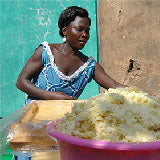The Reality of Human Trafficking Today

January 11th is recognized as National Human Trafficking Day in the United States. This day serves as a reminder of the devastating human rights issue of human trafficking, which affects millions of people around the world, including the United States. Human trafficking is a form of modern-day slavery in which individuals are recruited, transported, or held against their will for the purpose of forced labor or sexual exploitation.
Human trafficking is a complex and multifaceted problem that affects people of all ages, genders, and backgrounds. It can take many forms, including sex trafficking, labor trafficking, and domestic servitude. Victims of human trafficking are often lured by false promises of employment, education, or a better life. Once in the traffickers' control, victims are often physically, emotionally, and financially exploited, and are often forced to work long hours for little or no pay, and live in inhumane conditions.
The International Labour Organization (ILO) estimates that 21 million people are victims of forced labor globally, with 4.5 million in forced sexual exploitation. Women and girls make up the majority of those who are exploited in the sex trade, while men and boys are disproportionately affected by forced labor trafficking. The ILO also estimates that forced labor generates US $150 billion in illegal yearly profits.
Human trafficking is a global problem that requires a global response. The United Nations Office on Drugs and Crime (UNODC) estimates that human trafficking generates around $32 billion annually, with $15.5 billion coming from developed countries. The U.S. Department of State estimates that there are thousands of victims of human trafficking within U.S. borders each year.
In the United States, the Victims of Trafficking and Violence Protection Act (TVPA) of 2000 is the federal law that addresses human trafficking and provides services and support to victims of trafficking. The TVPA defines severe forms of trafficking in persons as sex trafficking in which a commercial sex act is induced by force, fraud, or coercion, or in which the person induced to perform such an act is under 18 years of age; and, the recruitment, harboring, transportation, provision, or obtaining of a person for labor or services through the use of force, fraud, or coercion for the purpose of subjection to involuntary servitude, peonage, debt bondage, or slavery.
The U.S. government has taken a multi-disciplinary approach to combat human trafficking, by working to prevent trafficking, protect and assist victims, and prosecute traffickers. Through this approach, the U.S. government has implemented a number of initiatives, such as the Blue Campaign, which aims to raise awareness about human trafficking, and the National Human Trafficking Hotline, which provides assistance and support to victims of human trafficking.
The U.S. government has also worked to strengthen international cooperation to combat human trafficking by participating in bilateral and multilateral efforts to prevent and combat trafficking, including through the UN Voluntary Trust Fund for Victims of Trafficking in Persons and the UN Office on Drugs and Crime (UNODC) Global Initiative to Fight Human Trafficking.
However, it's important to note that there is still a long way to go in addressing this issue. The COVID-19 pandemic has only exacerbated the issue of human trafficking, as many individuals have lost their livelihoods and become more vulnerable to traffickers' promises of work and a better life. Therefore, it's crucial for people to be aware of the signs of human trafficking and to report any suspicious activity to the National Human Trafficking Hotline.

Here are some ways that individuals and communities can work to stop human trafficking:
- Educate themselves and others about the signs of human trafficking and how to report it.
- Support organizations that work to combat human trafficking, either through donations or volunteering.
- Pressure governments and international organizations to take action against human trafficking, by writing letters, signing petitions, and advocating for stronger laws and enforcement.
- Be mindful of the products they purchase and try to avoid products that may have been produced by forced labor.
- Be more vigilant and always report suspicious activities
- Support victims by providing them with legal, medical, and social services.
- Finally, support international coordinated efforts and cooperation in fighting human trafficking which is done by international organizations such as the United Nations, the International Labour Organization, and the International Organization for Migration.
















